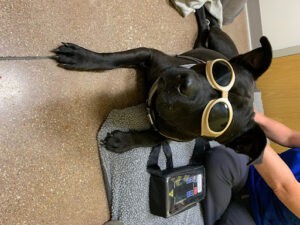Photobiomodulation
It’s like having coffee with your breakfast
If I say laser, what pictures immediately come to mind? Star trek weapons? Laser tag? The teacher’s red pointer? You may even conjure up a picture of laser surgery. What you probably didn’t picture is healing, tissue repair, decreasing inflammation, and increasing tissue perfusion. Did you know that laser therapy at an appropriate wavelength has a lot of uses in wound healing, pain management, and in treating inflammation?
Photobiomodulation is a fancy word for light therapy. Laser (which actually stands for light amplification by stimulated emission of radiation) is becoming increasingly popular to aid in healing and pain management! Here’s the secret: not all lasers are the same! At an appropriate wavelength, and used for an appropriate duration, laser therapy can be very therapeutic. (rather than destructive….)
Essentially photobiomodulation is a select wavelength of light that penetrates the tissue at a certain depth. It improves circulation, helps with pain management, causes vasodilation, improves muscle relaxation, and reduces inflammation at the cellular level. All of these things result in faster healing times, better pain control, and improved function.
How is the procedure performed?
The veterinarian prescribes a laser protocol, just as they would write a prescription for a medication. This prescription includes a location of the body and a duration of time. The laser can be administered by either a veterinary technician or by the veterinarian. The laser is positioned over the prescribed area. The laser is generally positioned lightly over a wound, or gently pressed into an area with soft tissue injury. This is not painful to the patient, and most pets receive the treatment very well. The hardest part is holding still! For some of our more wiggly patients, an aromatic snack is provided to improve the experience. One of our favorites is frozen baby food, right out of the jar. Where room temperature baby food can be quickly lapped up, frozen baby food provides a much longer distraction time!
Are there risks?
As with all procedures, there are risks. However, when the prescription is appropriate for the patient, these risks are really uncommon! When used correctly, side effects like thermal damage are very rare. The major safety risk is for both the people in the room, and the patient in the room. When the light from the laser enters the eye directly, retinal damage can occur. For this reason, anyone in the room where laser therapy is being performed will be asked to wear goggles. The patient gets to wear a pair of “doggles” during treatment. Let me be the first to say that doggles are significantly cuter than their human equivalent! Laser therapy is contraindicated in cancer patients, as the laser can make inappropriate cells (like cancer cells) grow faster too.
When do we recommend laser treatments?
Most commonly we use the laser on patients who need better pain control, or patients who need a lot of healing. Here’s a few examples:
- Wounds
- Fractures
- Post operative orthopedic patients- after an ACL repair or a bone fracture repair
- Arthritis
- ACL injuries (with or without surgery)
- Hip Dysplasia
- Back injury- Intervertebral Disc Disease
Laser is rarely the only therapy that is implemented. Rather laser therapy makes up a component of multimodal care. Multimodal care means implementing several methods of pain control and treatment. A classic example is a dachshund with back pain. Laser is an excellent addition to a balanced therapy with muscle relaxants, anti-inflammatory medications, and strict rest. You might say that laser therapy is the equivalent of adding coffee to your breakfast. Coffee alone doesn’t make for a good breakfast, but it makes the breakfast oh so much better!
If your pet is scheduled to undergo a major surgery, or if your pet struggles with pain from arthritis or injury, talk to your veterinarian about adding laser therapy as a part of his or her treatment!









